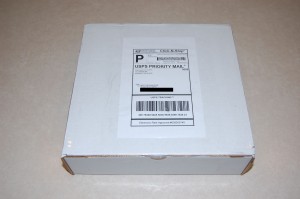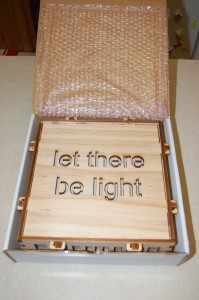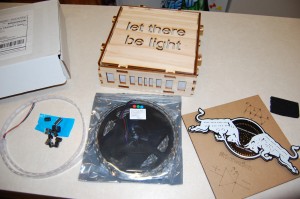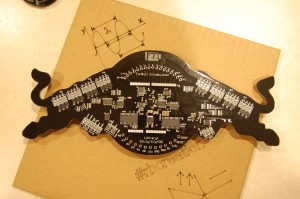The US Postal Service delivered my TurBULL Encabulator box on Monday. (This post is late to hit my blog because I've been heads-down writing contest code the past few nights.) As other blogs have demonstrated, it's quite the natty bit of packaging. Here's the magic package that the postman brought:
The plain white exterior opens to reveal a beautiful laser-cut plywood box. The Red Bull team spent some dollars on this; the packaging is downright gorgeous. The laser cut box and the tissue paper backing just beg for interior illumination.
Pulling out some of the wooden studs that hold the side panel onto the box, the side panel can be removed to reveal the blinky goodness within. The contents of the box include a 1m roll of individually addressable RGB LED pixels, 5m of all-the-same-color RGB LED strips, and of course the TurBULL Encabulator board, along with a handful of screw terminals that can be soldered onto the board.
The board is surprisingly large, and the routed shape is killer. There is no documentation with the board, but based on the silkscreen markings, there appear to be eight channels of all-the-same-color RGB LED drivers, a DMX512 output driver, a LED Pixel driver that can drive several types of LED pixel strips, an onboard accelerometer, an onboard temperature sensor, and an EEPROM. All of these peripherals are apparently on one I2C chain. The I2C address of each device is included on the silkscreen. Most of the peripherals have a dedicated PIC chip doing the I2C listening and performing the work. This is the best picture I took that shows the silkscreen. The white headers are Arduino-compatible. Click for a high-res version that allows you to read the silkscreen.
I find the lack of documentation frustrating. The Red Bull Creation team has supplied an Arduino library to work with the board, which is a start, but has two problems. The first problem is the simple fact that sample code is not the same as documentation. The second, larger issue is that I don't plan on driving my board with an Arduino (I know: heresy, right?) and therefore the Arduino library really doesn't do much for me. Now I have to reverse engineer the Arduino code into my controller's code on top of developing my project on this really tight timetable. Hey Red Bull team: documentation and a schematic would be really useful!
Having said that, the board is obviously a high quality board and there are lots of fun things to play with here. I'll be able to figure 'em all out; it'd just be a lot easier with proper documentation.
I have a project idea in mind that is a bit ambitious but I think can get me into the finals. I placed an order for a Raspberry Pi the other day and last night ordered some rolls of LED strips from China that I sincerely hope will arrive before the contest deadline. Since I don't have the R-Pi on hand, I've started developing my code in an Ubuntu VM hoping that the source can be migrated seamlessly to the R-Pi and compiled there.



